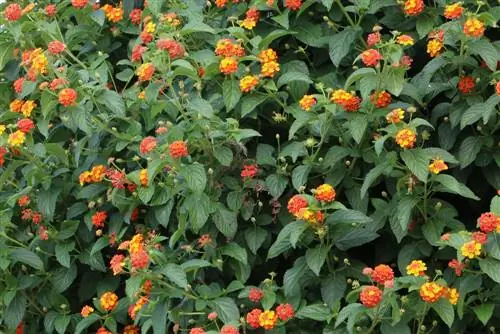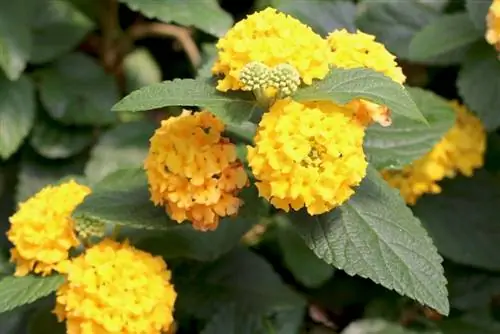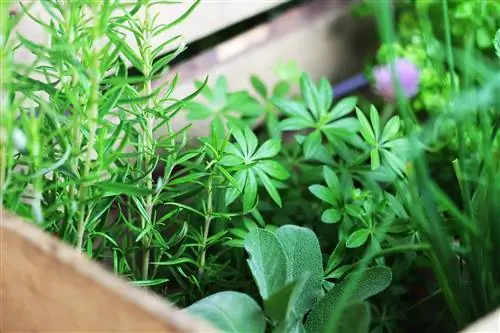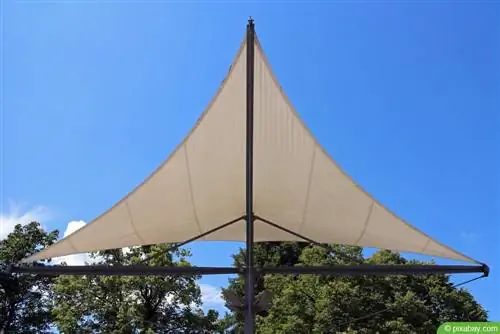- Author admin [email protected].
- Public 2023-12-17 03:39.
- Last modified 2025-06-01 06:48.
In the Mediterranean garden and on the summer balcony, lantana is an integral part of the repertoire. Unfortunately, the floral beauties from the tropics and subtropics are far too often thrown away after a single season because they shiver at temperatures below 10 degrees Celsius. What is overlooked is that the opulent verbena plants have the vitality of a perennial. In their South American habitats, Lantana camara are even considered invasive plants. However, the pronounced sensitivity to cold prevents invasive spread in Central Europe because the plants cannot survive a winter outdoors. Of course, cultivating them as perennial plants does not contradict this. In order for lantana to transform your garden into a sea of flowers every year, the plants must overwinter frost-free and undergo maintenance pruning.
When is the right time to prune?
In autumn, Lantana camara gradually stop growing in order to rest until the next spring. When the new growing season is approaching, it is the best time for shape and maintenance pruning. In this respect, the plants do not differ from other woody potted plants. The reason for the appointment recommendation is that even a slight cut is met with renewed shoots. Only when wintering is approaching in March or April should you cut off the branches. Pampered by the first warm rays of sunshine, the young shoots encounter ideal conditions for vital growth with numerous buds and flowers.
Preparatory work in autumn - cutting only permitted in exceptional cases

Preparations for late winter pruning begin in autumn by putting away your lantana in good time. If the ornamental tree suffers a cold shock, a total failure is inevitable, and even the best pruning can no longer change it. A minimum-maximum thermometer shows when the right time has come to move to winter quarters. How to do it right:
- Store when temperatures are around 10 degrees Celsius at night
- Set up the pot in a bright, frost-free winter quarters
- Temperature level of at least 5 and maximum 15 degrees Celsius
- Do not apply fertilizer from October to March
- Watering with soft water every now and then
Experience has shown that space in the bright, slightly temperate winter quarters is limited because numerous exotic plant species overwinter under these conditions. When your winter guests harass each other, fungal infections and pests have an easy time of it. If you are affected by this problem, cut back your lantana superficially before putting it away. Shorten shoots that are too long so that the overwintering plants do not touch each other.
Tip:
There is no cause for concern if lantana sheds its leaves in winter quarters. On the contrary, pruning is easier if there are no leaves blocking the view for the correct cut.
How to cut lantana correctly - step-by-step instructions
It's not just important to consider when to cut back Lantana camara. Where you place the scissors is also important. How far you cut the branches also influences the intensity of the subsequent sprouting. The following instructions provide step-by-step instructions on how to do it correctly:
- Initially cut off all dead and damaged branches at the base
- Thinning out branches that point diagonally inwards
- Remove the weaker ones from shoots that are too close or rubbing against each other
- Short the remaining shoots by one to two thirds
- Cut the bush or crown into a spherical, oval or pyramidal shape
- Place the sharp, disinfected scissors just above an outward-facing leaf or eye
An important law of growth states that a vigorous pruning is responded to by an equally vigorous sprouting of young branches. Since popular species and varieties bloom most beautifully on this year's shoots, you cannot cut off buds that have already formed at the recommended time in late winter. Therefore, go to work boldly if you want the flowering tree to repeat its furious play of colors from spring to autumn. Careful removal of the tips causes unsightly broom shoots, the shadows of which are cast inside the bush, cutting off leaves, buds and flowers from sunlight, which ultimately ends in senescence.
Cut off the faded flowers - or not?
During the long-lasting flowering period from May/June to September, the lantana is constantly growing and dying. A single flower only lasts a few weeks before it withers and the next buds develop. Blossoming is therefore common on the branches from early summer onwards. What you do with wilted flowers is a personal decision. If you leave the dead flowers on the bush, they will form small, black berries that are vaguely reminiscent of raspberries. If you continually clean out withered flowers, your lantana will maintain its well-groomed appearance and save the energy needed to grow seeds. The ornamental tree invests the forces released in the growth and creation of further buds and flowers.
Did you know that the dark berries of all Lantana species and varieties are poisonous?
If the fruits are eaten intentionally or unintentionally, symptoms of poisoning appear that are similar to belladonna poisoning. Lantanas are therefore not suitable for cultivation in the family household. In addition, the clippings should not be disposed of in the compost if pets or grazing livestock have access.
Cutting lantana in summer - is that possible?

In the sunny, warm location, the exotic verbena plants demonstrate their vigor and grow rapidly in size. In a small garden or container, this vitality can lead to space problems. Since the growth goes hand in hand with a robust tolerance to cutting, you can also use scissors in the middle of the season. If shoots are too long, shorten them until the plant blends harmoniously into the overall impression of the bed and balcony. Please do not throw away cut, flowering branches. Placed in a vase with fresh, soft water, you can enjoy the flowers for many days to come.
Tip:
In combination with sunshine, the plant sap can be phototoxic and cause a skin rash. Please wear gloves and long-sleeved clothing for cutting work.
Education to become a standard child - This is how it works
Are you looking for a standard tree with a round, flowery crown? Then the wonderful lantana is the ideal choice for this decorative variant of a container plant. Of course, recreational gardeners don't miss the opportunity to train a young plant into a standard tree themselves. This saves money and brings a lot of joy when the young plant turns into a floral work of art. All you need is a little patience until the flowering tree presents itself in a perfect silhouette. The following instructions explain how to do it:
- Tie the central shoot to a support rod as a future trunk
- Remove all other ground shoots and side branches
- Do not cut the shoot tip
- In parallel with growth, tie the central shoot to the rod
- Consistently cut competing and side shoots back to the base
By cutting the tip of the central shoot, you initiate branching to the crown. Therefore, wait until the trunk has reached the desired height and exceeded it by about 4 leaves before making this cut. Increasing the trunk afterwards is rarely successful. From this point on, cut back the side shoots at the crown height by one to two thirds every spring so that they branch out numerously. As a result, a beautiful, round crown will form over the next few years. It is important to note that you combine the training cut with a maintenance cut. Thoroughly thin out dead wood, sick, weak and broken shoots for a light-flooded, flower-rich crown. Anything that sprouts from the trunk below the crown will be removed promptly.






